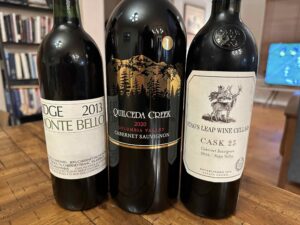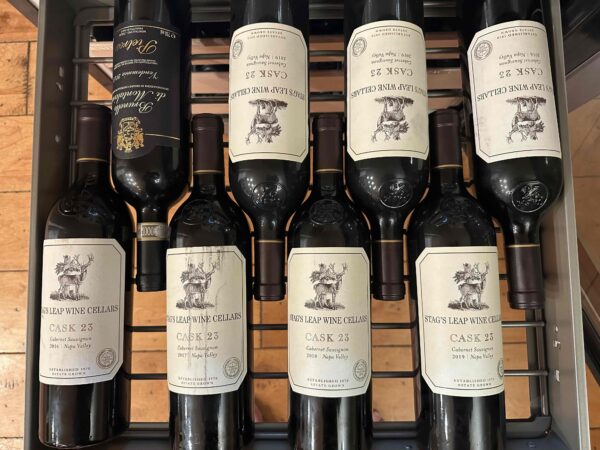Time for a holiday note, even if a bit cranky. Friday’s Wall Street Journal “Arts and Culture” section has a feature entitled “How to Become a Wine Snob in Five Easy Steps.” I’m thinking the article is ironic, deliberately intended to annoy serious oenophiles. Like me. Herewith the headlines for the five steps, with brief commentary:
1. Talk about your “wine journey.”
How ’bout not. I might hit you.
2. Espouse a “wine philosophy.”
Only allowed if you can begin with a citation about wine from a Platonic dialogue, such as The Laws or The Symposium. Otherwise shut the hell up about your solipsism.
3. Develop an intense interest in glassware.
Okay, there’s a little something to this, but I suspect this is mostly propaganda from “Big Glass,” which is a front for Riedel.
4. Pooh-pooh Popular Wines.
Morons. Popular wines subsidize the production of truly premium wines.
5. Buy wine only in magnums.
Okay, half a point here, but magnums don’t work for everyday drinking for two, because you won’t finish a magnum. Though I have been known to stock some magnums for bigger dinner parties (see nearby photo).
As it happens, I once upon a time wrote a send-up of wine writing, way back in . . . 1989. In other words, before the internet, so my article, “A Truly Fine Whine,” published in a local southern California magazine, is not available anywhere on the internet. So here’s my rebuttal, so to speak, on the Journal‘s misfire (note that one of the wineries I mention toward the end of this article went out of business more than 20 years ago, while the last one became Sobon Wine):
I receive at home three monthly journals with “Spectator” in their names. They are: The Spectator (of London), The American Spectator, and—The Wine Spectator. Guess which is my favorite, and the most thoroughly read? Bingo.
However, a fondness for wine can corrupt one’s good character. A quick perusal of The Wine Spectator shows why. Talking about wine lends itself to the same kind of silly jargon that has justified the fraud called “modern art” (an oxymoron if there ever was one) and ruined literary criticism. Someday I’m going to write a book about the subject. I’ll call it Higher Humbug for the Truly Pretentious: How to Sound Like George Plimpton in Three Easy Lessons. Chapter one will be about modern art. Any fool can see that you need more than a tweed coat and turtleneck to get by at the Guggenheim. You need to know the lingua franca of the art world.
My favorite example of the Higher Humbug in action comes from New York Senator Daniel Moynihan, who, pondering a heap of scrap metal named “Isis” in a museum a few years back, had the presence of mind to remark profoundly: “Isis achieves a transubstantiation that is at once elusive yet ineluctable in the modern sensibility.” As good a reason as any, I suppose, for the voters of New York to retire the good senator in the next election. Kurt Vonnegut was right when he said that modern art is a conspiracy between rich people and “artists” to make ordinary people feel stupid.
And the less said about literary criticism the better. The degradation of criticism through “Deconstructionism” and other preposterous fads may yet achieve the unthinkable: the writing of novels so unreadable that even the critics will look for another line of work.
Fortunately, the world of wine criticism awaits any of the lit. crit. washouts. The lingo of the wine world is fully developed. Get command of it, and you can terrify and humiliate any host or hostess in the land. All you need do is await your host’s solicitation on the evening’s main wine, look thoughtful, and say, “Superb, but—it dies a sudden death on the middle palate.” If you wish to mitigate this cruel blow, you can add, “But it finishes well.” We can see the headlines in the local tabloids now: “Publishing Mogul Brought Low by Cheeky Chardonnay.”
Higher wine criticism depends wholly upon a few simple adjectives of more than usual subjectivity when applied to the fruit of the vine. Today a fine red wine will be described as “big, full, complex, with a long finish.” “Intense, crisp, firm, tight, and elegant” are also in fashion at the moment.
Putting down a wine can be a lot of fun, but involves the same ponderous prose. Consider this Wine Spectator evaluation of a Lyeth 1986 Sauvignon Blanc: “Perfumed and spicy with floral notes, more like a Gewurtztraminer than a Sauvignon Blanc, finishing dry, flat and slightly bitter. Tasted twice.” It’s the “tasted twice” that really seals the fate of this wine.
Or consider this assessment of a Chateau Woltner 1987 Chardonnay: “Has an extreme style that’s hard and austere . . . a wine of disjointed character and little charm.” Now, I’ve had my prose described this way, but never my wine. I can envision a pub with the sign: “Shirt and shoes required. No disjointed wine served here.”
For a while, wine writers overused “oak” as a descriptive term, since most wine is aged in oak barrels. (Real snobs inquired what kind of oak: Yugoslavian, French, or American. And how many times does the winery reuse their barrels?) You still see it from time to time, but its use has diminished ever since it became possible to deflate a wine critic by pointing out that a particular “oaky” wine was fermented and aged in stainless steel vats, and never touched wood. (And by the way, why is “cork” flavor never mentioned?)
“Bramble” was much in fashion for a while in the 1970s, and even appeared on the labels of a few brands. It finally disappeared when people caught on that no one except Ewell Gibbons had any idea what “bramble” tastes like. But I think I’ve spotted the next bogus trend. Here’s the Wine Spectator’s rating of Ferrari Carano’s 1988 Fume Blanc: “Rich, intense and concentrated with round, smooth fruit that offers grapefruit, citrus, fig and stone flavors that finish with a soft touch.” “Stone flavors?” I don’t think I want to know.
Just so with wine. None of the Higher Humbug with me. I’ll cheerfully tell you what I think is good. Herewith my three favorite wineries from three different regions of the state:
- Stag’s Leap Wine Cellars, Silverado Trail, Napa Valley. Stag’s Leap makes my favorite Cabernet Sauvignon, bar none. Stag’s Leap Cabernet won a prestigious blind tasting in Paris a few years ago, much to the chagrin of the French. President Reagan served it to both Gorbachev and Queen Elizabeth during their visits. Best of all, Stag’s Leap owner Warren Winiarski was once a graduate student of political philosophy at the University of Chicago; you can chat with him about Machiavelli and Hobbes when you attend a tasting at the winery. Right now Stag’s Leap is selling its 1986 bottling of Cabernet. Get the SLV premium bottling—it’s worth the price ($26). Or get on the mailing list and get Cask 23, the ultra-premium release. Stag’s Leap also makes a very good Petit Sirah.
-
Mastantuano, Vineyard Drive and Hwy. 46, Paso Robles. Wine making in the Paso Robles area has been exploding in recent years, and although most of these new vintners are still several years away from producing truly premium wines, a few of the older winemakers have come into their own. The best of these is Mastantuano, named for its long time owner, Pasquale Mastantuano. Mastantuano has a long tradition of exceptional Zinfandels, but also makes a good, reasonably-priced Cabernet Sauvignon. If you like desert wines, don’t overlook Mastantuano’s very creditable Muscat Canelli.
-
Shenandoah Vineyards, Shenandoah Valley Road, Plymouth, Amador County. The wineries of the Sierra foothills tend to be overlooked with good reason, but there are some notable exceptions in the Gold Country near Jackson, off Hwy. 49. The best are Shenandoah and Montevina. Shenandoah makes excellent Zinfandel and Cabernet Sauvignon, and offers several vintages of each. They also make several port wines, none of which I liked, but your tastes may be less finicky than mine. Best of all, because Shenandoah doesn’t sport an address in Napa Valley, its prices are very reasonable. Shenandoah and Montevina (which I’ll get to next time around) make great diversions on a trip through the Gold Country.
Meanwhile, part of my survival kit for the apocalypse (or Christmas week, whichever comes first):


Notice: All comments are subject to moderation. Our comments are intended to be a forum for civil discourse bearing on the subject under discussion. Commenters who stray beyond the bounds of civility or employ what we deem gratuitous vulgarity in a comment — including, but not limited to, “s***,” “f***,” “a*******,” or one of their many variants — will be banned without further notice in the sole discretion of the site moderator.